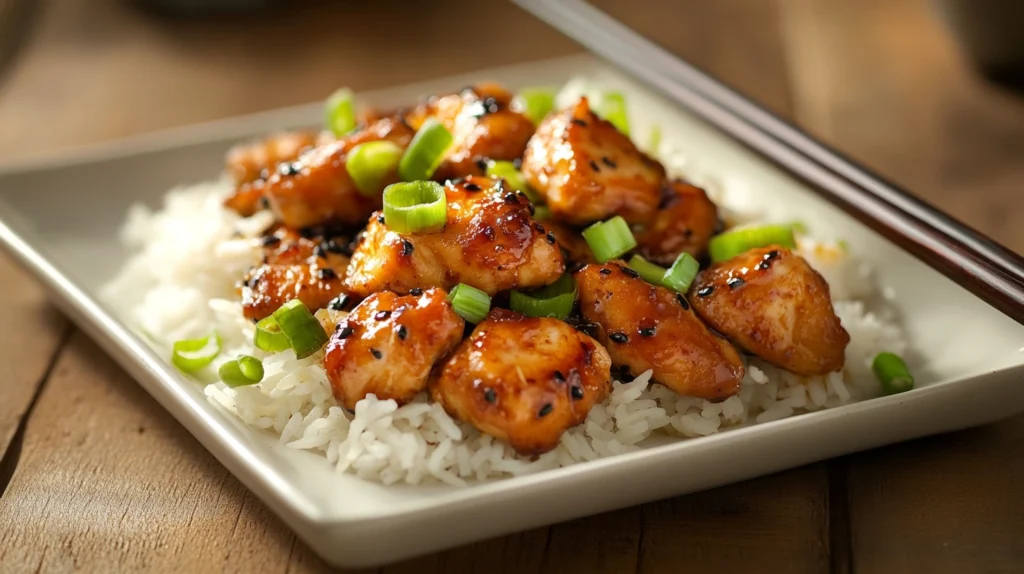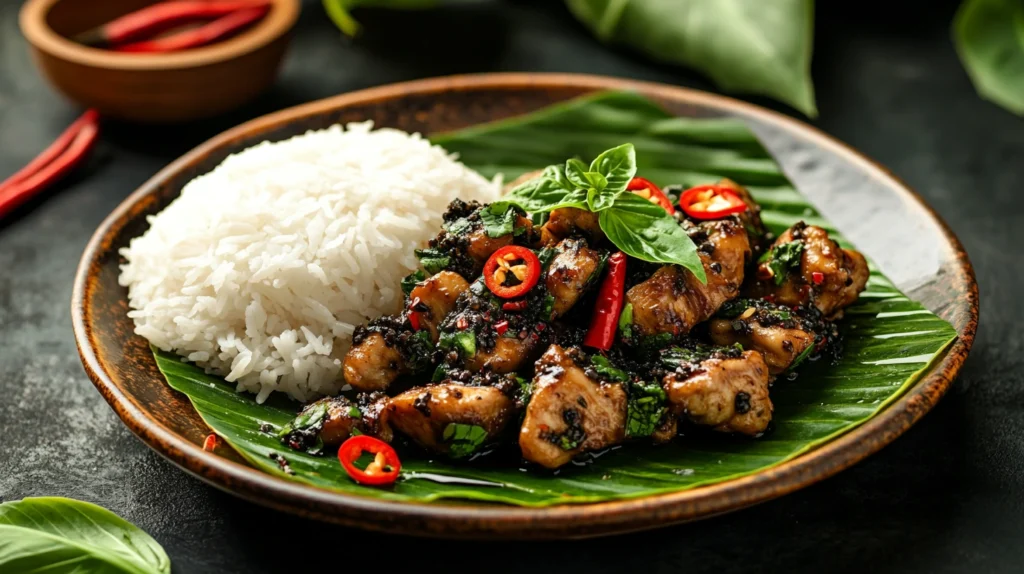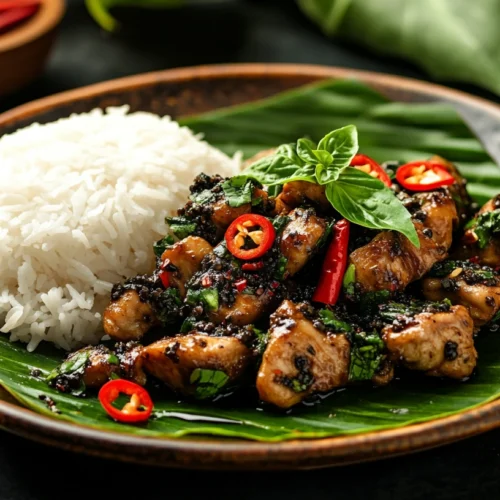Black Pepper Chicken is more than just another stir-fry—it’s a celebration of bold flavor, simplicity, and versatility. Whether you’ve tasted it at a local Chinese restaurant or spotted it on a trending food blog, chances are, this spicy-sweet dish left a lasting impression. Loved for its sizzling aroma, peppery punch, and savory glaze, Black Pepper Chicken has become a staple in both traditional Asian kitchens and modern fusion menus.
This beloved dish combines tender chicken pieces with a vibrant mix of bell peppers, onions, and sometimes celery, all bathed in a glossy, pepper-infused sauce. But the star ingredient, unsurprisingly, is black pepper—a spice that has long been hailed not just for its flavor, but also for its healing properties and rich culinary history.
What makes Black Pepper Chicken especially popular is its adaptability. You can keep it lean and healthy with grilled chicken and steamed vegetables, or go indulgent with extra sauce and rice. From busy weeknight dinners to dinner parties with a twist, this dish checks all the boxes.
In this article, we’ll take a flavorful journey through the world of Black Pepper Chicken—exploring its origins, nutritional benefits, cooking techniques, and mouth-watering variations. You’ll also find tips on avoiding common cooking mistakes, FAQs answered by culinary experts, and serving ideas to elevate your next meal.
Whether you’re a seasoned home cook or a curious food lover eager to try something new, this guide is your go-to resource for mastering the art of Black Pepper Chicken.
Ready to spice up your kitchen? Let’s get started.
The Origins and Global Rise of Black Pepper Chicken
Black Pepper Chicken may seem like a modern dish, especially with its popularity in fast-casual Asian restaurants, but its roots run deeper than many realize. This dish has evolved over centuries, tracing back to Chinese culinary traditions while absorbing global influences along the way.
Chinese Origins and Sichuan Influence
The earliest versions of Black Pepper Chicken can be traced to Chinese cuisine, particularly from the southern regions where bold, spicy flavors are embraced. While Sichuan cuisine is famous for its tongue-tingling heat, black pepper was often used in regions where Sichuan peppercorns were either unavailable or too intense for everyday dishes. In traditional Chinese kitchens, black pepper was viewed as both a seasoning and a medicinal spice used to warm the body and aid digestion.
The stir-fry technique, essential to Black Pepper Chicken, is also a cornerstone of Chinese cooking. Wok-fried meats combined with aromatics like garlic, ginger, and scallions were a common preparation method—quick, efficient, and bursting with flavor.
Global Spread Through Migration and Fusion
As Chinese immigrants settled around the world, particularly in Southeast Asia and North America, they brought their food culture with them. Dishes were adapted based on available ingredients, local tastes, and dietary preferences. In places like Malaysia, Singapore, and Thailand, Black Pepper Chicken took on regional flair, incorporating local spices, herbs, and sauces.
In the United States, the dish rose to prominence with the growth of Chinese-American cuisine. It became a popular choice on takeout menus, often served alongside fried rice or lo mein. Chains like Panda Express helped introduce the dish to a broader audience, offering a milder, sweeter version of the original.
Today, you’ll find dozens of variations of Black Pepper Chicken—from gourmet interpretations in upscale restaurants to quick homemade versions shared on TikTok and YouTube. Its journey is a testament to how a simple dish can transcend borders and blend cultures on a single plate.
This savory stir-fry traces its roots to southern Chinese cuisine, where bold flavors and quick wok-cooking define mealtime. Much like the Jamaican Curry Chicken, it’s a globally traveled dish that has picked up influences along the way—from Southeast Asia to the American takeout scene.
Why Black Pepper Chicken Stands Out Among Asian Chicken Recipes?
So, what exactly sets Black Pepper Chicken apart from other stir-fried dishes like Kung Pao Chicken or General Tso’s? It all comes down to flavor balance, simplicity, and pepper-forward seasoning.
The Signature Flavor Profile
Black Pepper Chicken boasts a perfect harmony of spicy, savory, and slightly sweet notes. The heat doesn’t come from chili peppers but from freshly cracked black pepper, which delivers a distinct warm spiciness that builds with each bite. Combined with soy sauce, garlic, and sometimes oyster sauce or rice wine, the result is a glossy, umami-packed sauce that clings to every piece of meat and vegetable.
Unlike other spicy dishes that rely on overpowering heat, Black Pepper Chicken uses pepper strategically. The spice enhances the flavor without overwhelming the senses, making it suitable for all palates.
Minimalist, Yet Flavorful
One of the dish’s biggest strengths is its simplicity. You don’t need a long list of exotic spices or ingredients—just high-quality chicken, fresh vegetables, black pepper, and a few pantry staples. The entire dish can be prepared in under 30 minutes, making it ideal for busy weeknights or meal prepping.
A Dish That Celebrates Black Pepper
While many dishes use pepper as a background note, Black Pepper Chicken puts it front and center. The spice is toasted or freshly ground to unleash its aromatic oils, which mingle with the hot wok and create that unmistakable sizzle and smoky aroma. Few dishes showcase black pepper as beautifully and boldly as this one.
Endless Customization
Another reason this dish stands out is how easy it is to adapt. Want it spicy? Add chili flakes. Watching carbs? Skip the rice and serve it in lettuce wraps. Cooking for kids? Use a lighter hand with the pepper. This flexibility makes it a favorite for home cooks who like to experiment without straying too far from tradition.
Ingredients Breakdown

The beauty of Black Pepper Chicken lies in its straightforward ingredient list. It’s the kind of dish that proves you don’t need a pantry full of specialty items to create bold, restaurant-worthy flavor. However, understanding the role each ingredient plays—and choosing the right ones—can elevate your dish from good to unforgettable.
Whether you’re cooking a quick weeknight meal or preparing a special dinner for guests, the right ingredients make all the difference. Let’s break down what goes into an unforgettable Black Pepper Chicken recipe.
Best Chicken Cuts for Juicy Black Pepper Chicken
Chicken Thighs vs. Chicken Breasts
Your choice of chicken determines the dish’s juiciness and texture. While both chicken thighs and breasts work well, each offers a slightly different eating experience:
- Chicken Thighs (Boneless, Skinless)
These are often preferred for Black Pepper Chicken due to their higher fat content and rich flavor. They remain tender and juicy even after stir-frying at high heat. - Chicken Breasts
Leaner and lighter, chicken breasts are a healthier option for those watching fat intake. However, they can dry out quickly if overcooked, so timing is key. If you’re using breasts, marinating beforehand helps retain moisture.
Tips for Prepping Chicken
- Slice Against the Grain: This keeps the chicken tender.
- Uniform Cuts: For even cooking, aim for bite-sized, equally thick pieces.
- Marinate for Depth: A simple marinade with soy sauce, garlic, and a pinch of cornstarch enhances flavor and improves texture.
How Fresh Black Pepper Transforms This Stir-Fried Chicken Dish
If chicken is the body of this dish, black pepper is the soul. While often an afterthought in many recipes, here it takes center stage, adding complexity, heat, and aroma.
Types of Black Pepper
- Tellicherry Black Peppercorns
Often considered the gold standard, these are larger, more mature peppercorns from India. They offer a deep, citrusy flavor and a powerful kick. - Malabar Black Pepper
Also grown in India, this variety has a milder heat with earthy, slightly woody notes. It’s great for a more balanced pepper flavor. - White Pepper
Milder and slightly fermented in taste, white pepper can be used for a subtler flavor or blended with black pepper for added complexity. However, it’s not commonly used in traditional Black Pepper Chicken recipes. - Pre-Ground vs. Freshly Cracked
Always opt for freshly cracked black pepper over pre-ground. The oils released from freshly grinding the peppercorns give the dish its bold, spicy aroma.
Need the perfect side? Try pairing this with a Cheese-Stuffed Garlic Naan or some Roasted Broccoli and Carrots for a wholesome twist.
How Much Is Too Much?
This dish is all about balance. For an average 4-serving recipe, 1 to 2 teaspoons of freshly ground black pepper usually hits the sweet spot. If you’re a spice lover, you can push it slightly higher—but remember, too much can overshadow the other flavors.
Supporting Cast: Vegetables & Sauce Ingredients
Though chicken and black pepper steal the spotlight, the other ingredients play important supporting roles:
- Bell Peppers (Red, Green, Yellow): Add color, crunch, and natural sweetness to balance the peppery heat.
- Onions: Caramelize slightly during stir-frying and contribute sweetness and depth.
- Garlic & Ginger: Essential aromatics that provide an umami base layer.
- Soy Sauce: Brings saltiness and savory umami.
- Oyster Sauce (Optional): Adds richness and a hint of sweetness.
- Cornstarch Slurry: Used to thicken the sauce and give it that glossy finish.
Together, these ingredients create a flavor-packed, texturally dynamic dish that delivers comfort and excitement in every bite.
How to Make Black Pepper Chicken at Home – Step-by-Step Guide
Cooking Black Pepper Chicken is a rewarding experience. The sizzle of chicken hitting a hot wok, the spicy aroma of black pepper wafting through the kitchen—it’s an event for the senses. While the recipe is simple, technique matters. The right method ensures the chicken stays juicy, the vegetables retain their crunch, and the sauce has just the right consistency.
Here’s a step-by-step guide to help you prepare Black Pepper Chicken that rivals your favorite takeout.
Step-by-Step Cooking Instructions
Marinate the Chicken
Start by marinating your chicken pieces with the following ingredients:
- 2 tbsp soy sauce
- 1 tsp freshly cracked black pepper
- 1 tsp cornstarch
- 1 tsp sesame oil (optional)
- 1 clove garlic (minced)
Let it sit for at least 15–20 minutes to allow the flavors to penetrate and tenderize the meat.
Prep the Vegetables
Slice your vegetables uniformly for even cooking:
- 1 red bell pepper
- 1 green bell pepper
- 1 small onion
- Optional: celery, scallions, or mushrooms
Mix the Sauce
In a small bowl, combine:
- 2 tbsp soy sauce
- 1 tbsp oyster sauce
- 1 tsp sugar
- ½ cup chicken broth or water
- 1 tsp cornstarch
This sauce will coat the ingredients and create that classic glossy finish.
Stir-Fry
- Heat oil in a wok or large skillet over medium-high heat until shimmering.
- Add the marinated chicken and stir-fry for 4–5 minutes until lightly browned and cooked through. Remove and set aside.
- In the same wok, add garlic, ginger, and onion. Sauté until aromatic.
- Toss in the bell peppers and other vegetables. Stir-fry for 2–3 minutes to retain their crunch.
- Return the chicken to the wok and pour in the sauce mixture.
- Stir everything together until the sauce thickens and coats the ingredients.
Top with an extra sprinkle of freshly cracked black pepper just before serving for that signature kick.
Tools and Techniques
Wok vs. Skillet
While a wok is the traditional tool for stir-frying, a heavy-bottomed non-stick skillet or cast iron pan works well too—just make sure it retains heat and allows for high-heat cooking.
The Importance of High Heat
Cooking over high heat is essential to get that slightly smoky, caramelized flavor known in Chinese cuisine as wok hei. Keep ingredients moving to avoid burning, and don’t overcrowd the pan—cook in batches if needed.
Oil Choices
Use oils with high smoke points such as:
- Peanut oil
- Sunflower oil
- Avocado oil
- Canola oil (neutral flavor)
Avoid olive oil, as it can burn at high temperatures.
Homemade Black Pepper Chicken vs. Takeout – Which Tastes Better?
Taste and Quality
- Homemade: Fresher ingredients, less oil, customizable spice level, and lower sodium.
- Takeout: Often heavier on sugar and oil, but ready in minutes with a more uniform texture from commercial woks and high-powered burners.
Health Comparison
- Homemade Black Pepper Chicken can be modified to suit dietary needs—low-sodium soy sauce, sugar substitutes, or air-fried chicken pieces.
- Takeout versions may include additives, MSG, or extra salt and fat to enhance flavor.
Cost and Convenience
Cooking at home is more cost-effective in the long run, especially when feeding a family. Plus, leftovers taste great reheated, making it an efficient choice for meal prep.
Is Black Pepper Chicken Healthy? Nutrition Facts & Benefits
Black Pepper Chicken isn’t just packed with flavor—it can also be packed with nutrients. Thanks to its lean protein content, metabolism-boosting spices, and fresh vegetables, this dish fits surprisingly well into many healthy eating plans. When made at home, it can be tailored to specific dietary needs, giving you full control over sodium, sugar, and fat levels.
Let’s break down what makes this dish a smart choice for health-conscious foodies.
Is It Healthy?
High in Protein
Chicken, especially lean cuts like breast meat, is an excellent source of high-quality protein. Protein is essential for building muscle, supporting immune function, and keeping you full for longer—making this dish a smart option for weight management and active lifestyles.
Low in Carbs (When Served Right)
Black Pepper Chicken can be a low-carb option if served with:
- Steamed vegetables
- Cauliflower rice
- Lettuce wraps
Avoiding white rice or sugary sauces helps reduce the carb load, making it perfect for low-carb and ketogenic diets.
Black Pepper’s Health Perks
Black pepper isn’t just a flavor enhancer—it’s a nutritional powerhouse. It contains piperine, a compound that:
- Improves digestion
- Boosts metabolism
- Increases the absorption of nutrients like vitamin B and selenium
- Acts as an antioxidant and anti-inflammatory agent
Adding freshly ground black pepper to your meals may even help manage cholesterol levels and support brain health, according to emerging research.
Vegetable Power
Including bell peppers and onions doesn’t just add color and crunch—they contribute fiber, vitamin C, and antioxidants. These ingredients support immune health and digestion, and they make the dish more balanced overall.
Make Black Pepper Chicken Keto, Gluten-Free, or Vegan
One of the best things about Black Pepper Chicken is its adaptability. You can tweak the ingredients without compromising on flavor, making it a dish almost anyone can enjoy.
Gluten-Free Option
- Use gluten-free soy sauce (such as tamari) or coconut aminos instead of regular soy sauce.
- Double-check that oyster sauce (if used) is labeled gluten-free or skip it entirely.
- Ensure cornstarch is gluten-free (most are, but it’s good to verify).
Low-Sodium Version
- Use low-sodium soy sauce.
- Skip added salt—black pepper provides enough bite.
- Choose fresh chicken over pre-marinated or frozen options that may contain added sodium.
Keto & Low-Carb Friendly
- Avoid any sugar in the sauce or replace it with monk fruit sweetener or erythritol.
- Serve with steamed leafy greens, zucchini noodles, or cauliflower rice.
- Skip cornstarch if extremely strict—use xanthan gum as a keto-friendly thickener instead.
Dairy-Free & Paleo Friendly
This dish is naturally dairy-free, and by removing soy-based products (and substituting coconut aminos), it can also be made paleo-compliant. Use arrowroot powder instead of cornstarch for thickening.
Vegetarian or Vegan Version
Swap chicken for:
- Firm tofu (press out water before cooking)
- Tempeh
- Seitan (for a meaty texture)
Use plant-based sauces like mushroom-based “oyster” sauce and ensure your soy sauce is vegan.
Black Pepper Chicken proves that you don’t have to sacrifice flavor to eat well. With thoughtful ingredient choices and mindful preparation, it’s a dish that checks both the taste and health boxes.
Best Ways to Serve Black Pepper Chicken – Rice, Noodles & More

Black Pepper Chicken is incredibly versatile when it comes to what you serve it with. Whether you’re keeping things light or going all-in with a comforting bowl of rice, here are some of the best pairing options to elevate your meal.
Rice & Noodles
- Steamed Jasmine Rice: A classic pairing that soaks up all the peppery sauce.
- Brown Rice or Quinoa: For a healthier twist and extra fiber.
- Fried Rice: Make it a full-on feast by pairing it with egg-fried or veggie-fried rice.
- Noodles: Serve over lo mein or rice noodles for a hearty alternative.
Low-Carb Sides
- Cauliflower Rice: A keto-friendly base that mimics the texture of rice.
- Zucchini Noodles: Adds freshness and keeps things light.
- Lettuce Cups: Use crunchy romaine or iceberg leaves for a fun wrap-style meal.
Drinks & Complements
- Green Tea or Jasmine Tea: Refreshing and light, helps cleanse the palate.
- Light Beer or Crisp White Wine: Pairs well with the peppery and umami flavors.
Global Twists on Classic Black Pepper Chicken Recipes

Black Pepper Chicken has traveled across continents, picking up influences and ingredients along the way.
American-Chinese Version
- Sweeter, thicker sauce
- More onions and bell peppers
- Sometimes includes celery for crunch
- Common in fast-casual chains like Panda Express
Southeast Asian Twists
- Malaysian Style: Adds curry leaves and uses bird’s eye chilies for extra heat.
- Thai Style: Often incorporates fish sauce, basil, and Thai peppercorns.
Fusion Recipes
- Black Pepper Chicken Wraps: Rolled into tortillas with slaw and spicy mayo.
- Rice Bowls: Served over jasmine rice with cucumber, pickled veggies, and fried egg.
- Tacos: Paired with cabbage and cilantro-lime sauce.
Cooking Black Pepper Chicken: Mistakes That Ruin the Flavor
Even a simple dish like Black Pepper Chicken can go wrong if not prepared carefully. Here are the pitfalls to dodge:
Overcooking the Chicken
High heat is key, but don’t overdo it. Chicken should be golden, not dry.
Using Pre-Ground Pepper
You’ll lose the aromatic oils that make this dish pop. Always grind fresh.
Overcrowding the Pan
This causes steaming instead of stir-frying. Cook in batches if needed.
Overseasoning
Go easy on soy sauce and oyster sauce if using both—too much can make the dish overly salty.
Frequently Asked Questions
What is black pepper sauce made of?
Black pepper sauce is a bold and savory condiment commonly used in Asian stir-fries, including Black Pepper Chicken. It’s typically made from a combination of:
- Freshly cracked black pepper
- Soy sauce
- Oyster sauce
- Garlic and ginger
- Chicken broth or water
- Sugar (for balance)
- Cornstarch (for thickening)
Some variations may include rice wine or sesame oil for added depth. The key is the freshly ground black pepper, which gives the sauce its signature spicy aroma and sharp kick. When cooked over high heat, the pepper infuses the sauce with a warm, smoky flavor that coats meats and vegetables beautifully.
Is Black Pepper Chicken good for you?
Yes, Black Pepper Chicken can be a healthy dish, especially when made at home with wholesome ingredients. Here’s why:
- High in protein from lean chicken breast or thighs.
- Low in carbs if you skip the rice or use cauliflower rice.
- Rich in antioxidants from black pepper, which contains piperine—a compound known to aid digestion and boost metabolism.
- Loaded with veggies like bell peppers and onions, which add fiber and vitamins.
To keep it healthy, go light on the oil and sodium, and use fresh, natural ingredients. Homemade versions are always a healthier alternative to restaurant or takeout versions, which may contain added sugar and excess salt.
What is in the Black Pepper Chicken at Panda Express?
The Black Pepper Chicken at Panda Express is a popular entree that offers a slightly sweet and peppery flavor profile. According to Panda Express, the dish includes:
- Marinated chicken breast strips
- Celery
- Onions
- A savory black pepper sauce
The sauce used in their version is typically thicker and a bit sweeter than traditional homemade versions, catering to American-Chinese cuisine preferences. It’s stir-fried in high-heat woks for a slightly caramelized flavor and usually served as part of a combo meal with rice or noodles.
Keep in mind that while it’s delicious, the restaurant version may be higher in sodium, sugar, and oil compared to a healthier homemade option.
What does black pepper do to meat?
Black pepper does more than just add heat—it plays a key role in enhancing meat’s natural flavor and improving its overall texture. Here’s what it does:
- Enhances Umami: Black pepper deepens the meat’s savory profile, making it taste richer.
- Adds Aromatics: Freshly ground pepper releases oils that create a warm, smoky aroma when cooked.
- Improves Digestion: Piperine in black pepper stimulates digestive enzymes, helping to break down proteins more effectively.
- Mildly Tenderizes: While not a strong tenderizer like acid-based marinades, black pepper can help improve the surface texture of meat when used in marinades.
In dishes like Black Pepper Chicken, it’s the pepper that creates that addictive bite and helps bring all the savory components together.
Conclusion
Black Pepper Chicken proves that sometimes, the simplest recipes are the most satisfying. With just a few ingredients, a trusty pan, and a handful of fresh vegetables, you can create a dish that rivals restaurant quality.
From its Chinese roots to its global popularity, Black Pepper Chicken is beloved for its bold flavor, quick prep time, and adaptability to any palate or dietary need. Whether you’re new to cooking or a seasoned home chef, this is a recipe worth mastering.
So grab your pepper grinder, fire up that skillet, and get ready to enjoy a dish that’s spicy, savory, and sure to become a regular at your dinner table

Black Pepper Chicken
Equipment
- Wok or large non-stick skillet
- Sharp knife
- Cutting board
- Mixing bowls
- Wooden spatula or tongs
- Small whisk
- Measuring spoons and cups
Ingredients
- For the Chicken Marinade:
- 1 lb 450g boneless, skinless chicken thighs or breasts, sliced thin
- 1 tbsp soy sauce
- 1 tsp freshly ground black pepper
- 1 tsp cornstarch
- 1 tsp sesame oil optional
- 1 clove garlic minced
- For the Sauce:
- 2 tbsp soy sauce
- 1 tbsp oyster sauce optional, for richness
- 1 tsp sugar or honey
- ½ cup chicken broth or water
- 1 tsp cornstarch
- Vegetables:
- 1 red bell pepper sliced
- 1 green bell pepper sliced
- 1 small onion sliced
- 1 tbsp fresh ginger minced
- 2 cloves garlic minced
- 1 –2 scallions chopped (for garnish)
- For Cooking:
- 2 tbsp high-heat oil canola, peanut, or sunflower
- Extra freshly ground black pepper to taste
Instructions
- Marinate the Chicken
- In a bowl, mix the sliced chicken with soy sauce, black pepper, cornstarch, sesame oil, and minced garlic. Let it marinate for at least 15 minutes.
- Prepare the Sauce
- In a small bowl, whisk together soy sauce, oyster sauce, sugar, chicken broth, and cornstarch. Set aside.
- Stir-Fry the Chicken
- Heat 1 tbsp oil in a wok over medium-high heat. Stir-fry the chicken until browned and cooked through (about 5–6 minutes). Remove and set aside.
- Stir-Fry the Vegetables
- In the same wok, add another tablespoon of oil. Sauté garlic, ginger, onions, and bell peppers for 2–3 minutes until slightly tender but still crisp.
- Combine Everything
- Return the chicken to the wok. Pour the sauce over and toss to coat everything. Cook for another 1–2 minutes until the sauce thickens and glazes the chicken.
- Finish and Serve
- Add a final sprinkle of freshly cracked black pepper and garnish with chopped scallions. Serve hot over steamed rice or noodles.

